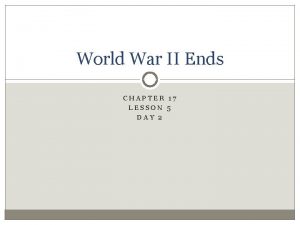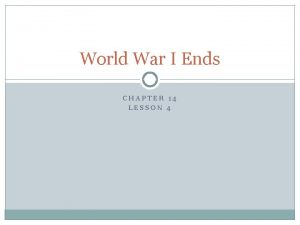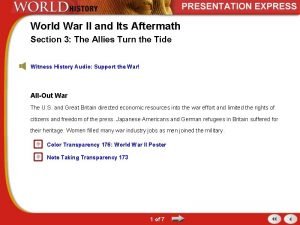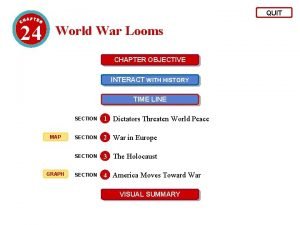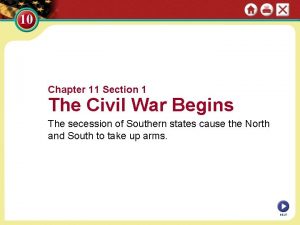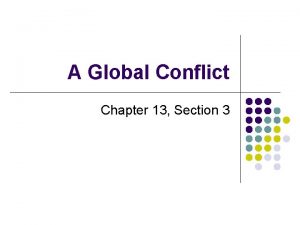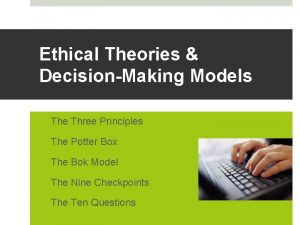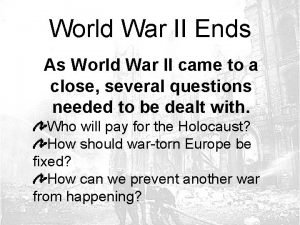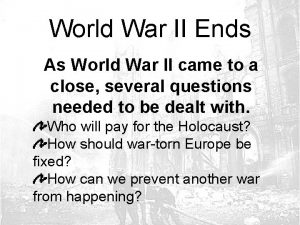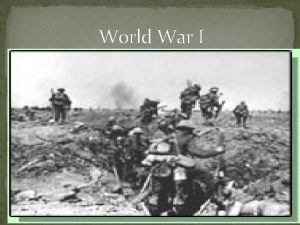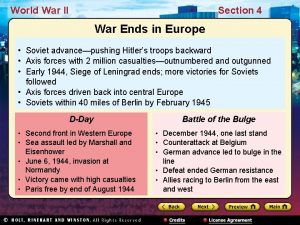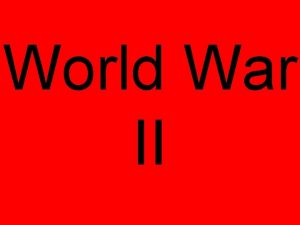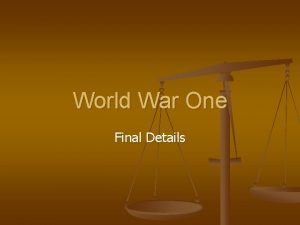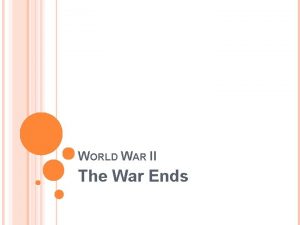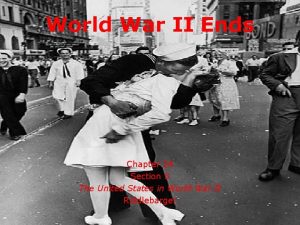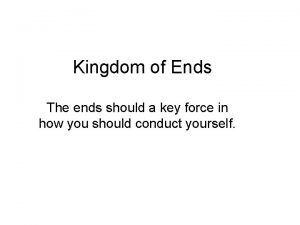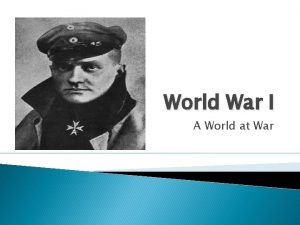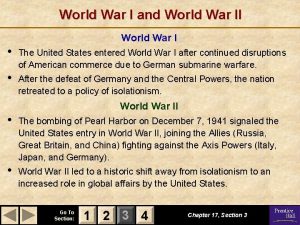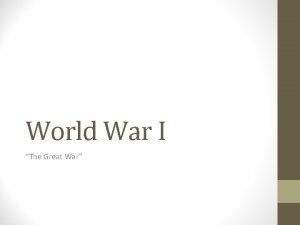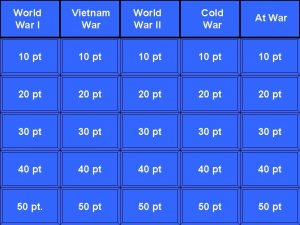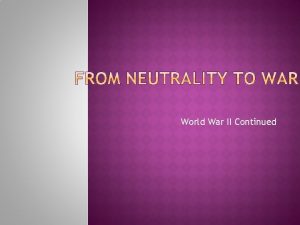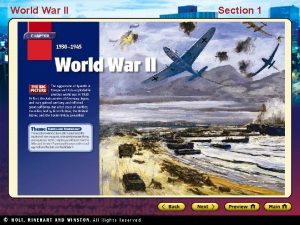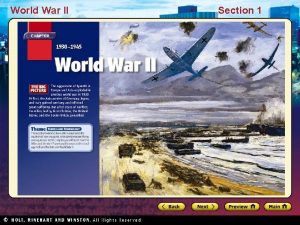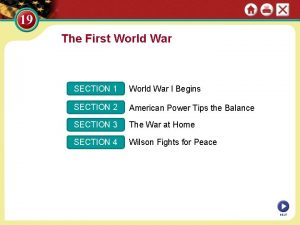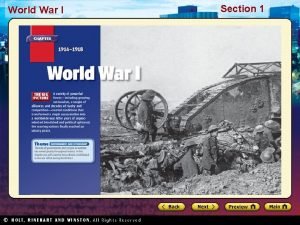Section 4 World War I The War Ends























- Slides: 23

Section 4 World War I The War Ends Preview • Main Idea / Reading Focus • The United States Enters the War • Faces of History: Woodrow Wilson • The End of the Fighting • A Difficult Peace • Map: Europe and the Middle East

Section 4 World War I The War Ends Preview, continued • The Costs of the War • Quick Facts: Effects of World War I • Visual Study Guide / Quick Facts • Video: The Impact of Modern Warfare

Section 4 World War I The War Ends Main Idea After several years of bloody stalemate-and the entry of the United States into the conflict-the Allied Powers finally prevailed. The peace, however, proved difficult to establish. Reading Focus • Why did the United States enter the war? • What events led to the end of the fighting? • What issues made the peace process difficult? • What were the costs of the war?

World War I Section 4 The United States Enters the War German attacks on ships carrying Americans angered American people, leaders • German plan to have Mexico attack U. S. also surfaced • American Neutrality – American public generally supported Allies – U. S. remained neutral officially – President Woodrow Wilson believed U. S. should stay out of affairs of other nations – “He kept us out of war”

World War I Section 4

World War I Section 4 Trouble on the seas • Remaining neutral not easy with Germany attacking civilian ships • Attacks part of policy called unrestricted submarine warfare • Any ship traveling in waters around Great Britain subject to attack by German U-boats Lusitania • Initially U-boats attacked only military, merchant ships • Passenger ship Lusitania sunk, 120 Americans among the dead • Fearing U. S. entry into war, Germany agreed to stop attacking passenger ships • Germany hoped to defeat Allied powers before U. S. entered war

Section 4 World War I The Zimmermann Note Final push to war • Repeated attacks on shipping brought U. S. close to war on Germany • Discovery of Zimmermann Note final push, February 1917 • Secret message from German diplomat Arthur Zimmermann to Mexico Contents of note • Germany proposed Mexico attack the U. S. in return for U. S. land • Promised Texas, Arizona and New Mexico, all once belonging to Mexico • Hoped war with Mexico would keep U. S. out of war in Europe Call for war • American public called for war against Germany • U. S. had kinship, financial ties to Great Britain, Allied Powers • U. S. entered war on side of Allied Powers, April 1917

World War I Section 4 Identify Cause and Effect How did unrestricted submarine warfare affect U. S. entry into the war? Answer(s): Germany broke its promise to the United States to stop attacking passenger ships.

Section 4 World War I The End of the Fighting German leaders knew America entering the war would increase the strength of Allied Powers. A New German Offensive Assault on West • Wanted to deal decisive blow to Central Powers before U. S. had time to ready for war • Opportunity came with Russia’s withdrawal from war • Launched major assault, March 1918 • Made progress, advanced to within 40 miles of Paris • High cost to Germany, lost 800, 000 troops • By June, 1918, U. S. troops arrived in Europe • Gave Allies hope, discouraged Germans – Russia out by end of 1917 – German troops no longer needed on Eastern front – Could launch new offensive in the west

Section 4 World War I German Collapse Balance of power shifted • Allied forces stopped German assault in Second Battle of the Marne • Allies now on the offensive • Allies used tanks, aircraft; gained huge amounts of territory Germany a defeated force • Many Germans gave up without a fight • Began to doubt their own power • Great turmoil within German ranks End of war • Allied forces broke through Hindenburg Line • German leaders sought armistice with Allies • Other Central Powers also admitted defeat, war ended

Section 4 World War I Summarize How did fighting come to an end? Answer(s): The Allies used tanks and aircraft at the Marne, then broke through the Hindenburg Line, and Germans sought an armistice.

Section 4 World War I A Difficult Peace Although peace had come to the battlefield, the leaders of the war’s major countries still had to work out a formal peace agreement. This task would prove difficult. Wilson’s Vision Allied Goals • Wilson announced his vision of world peace, Fourteen Points • Leaders of four major Allies all had different ideas of peace treaty • Included reduction of weapons, right of people to choose own government • French wanted to punish Germany, reparations for cost of war • Proposed organization of world nations, protect from aggression • British wanted to punish Germany, but not weaken it Italy’s leader hoped to gain territory for his nation, but was disappointed to find himself mostly ignored by other leaders during peace talks.

Section 4 World War I The Treaty of Versailles After difficult negotiations, the Allies finally compromised on the Treaty of Versailles. The treaty was named after the French Palace of Versailles, where the treaty signing took place. Key points Weaker Germany German reaction • Germany forced to pay enormous amount of money to war’s victims • Military size limited • Furious, though no choice but to sign • Treaty also assessed responsibility for the war on Germany • Return conquered lands to France, Russia • German land taken to form Poland • Other colonies given to various world powers • Reparations crippled economy • Bitterness would affect German politics in years to come

Section 4 World War I Aftermath League of Nations Main goals • Organization of world governments proposed by Wilson • Encourage cooperation, keep peace between nations • Established by Treaty of Versailles • U. S. did not ratify treaty, not member, weakened League Other treaties • Germany excluded Changes in Europe • Separate agreements with all defeated Central Powers • Austria-Hungary, Ottoman Empire lands broken apart • Made important changes to Europe • Independent nations created: Austria, Hungary, Yugoslavia, Czechoslovakia, Turkey

Section 4 World War I The Middle East Changes in Middle East • Former Ottoman lands turned into mandates, territories to be ruled by European powers Zionist movement • Movement to create a Jewish state in the Middle East • Syria, Lebanon became French mandates • Balfour Declaration favored establishing Jewish state in Palestine • Palestine, Iraq became British mandates • Britain created Transjordan from Palestine Mandate • European nations supposed to control mandates only until they were able to govern selves • Mandates eventually became colonies

World War I Section 4

Section 4 World War I Summarize Why was it so difficult to work out a peace agreement? Answer(s): because each of the four major Allies had different goals

Section 4 World War I The Costs of the War Human Costs • Nearly 9 million soldiers killed in battle • Millions wounded, taken prisoner • Almost an entire generation of young German, Russian, French men died, were wounded in war • Deadly outbreak of influenza spread by returning soldiers killed some 50 million worldwide, spring 1918 Economic Costs Political Changes War destroyed national economies Farmland, cities devastated Economic chaos in much of Europe Cost Europe role as dominant economic region of world • U. S. , Japan, others prospered during war • World War I caused widespread political unrest • Communist revolution in Russia • Monarchies in Austria-Hungary, Ottoman Empire overthrown • Political, social turmoil would shape world in years to come • •

Section 4 World War I The Costs of the War Unrest in Colonies • Many colonists who fought in war heard noble words about importance of freedom, democracy • After fighting for colonial rulers, expected rights for themselves • Wartime sacrifices did not win new freedoms • European powers split up lands controlled by Germans, Austro-Hungarians, Ottomans and redistributed them to other colonial powers

World War I Section 4

Section 4 World War I Summarize What were the costs of the war? Answer(s): Millions of people died or were wounded. Some nations' economies were devastated while others prospered. Some people enjoyed the benefits of freedom and democracy after the war, but others remained under the control of colonial rulers.

World War I Section 4

Section 4 World War I Video The Impact of Modern Warfare Click above to play the video.
 Lesson 5 world war 2 ends
Lesson 5 world war 2 ends Lesson 4 world war 1 ends
Lesson 4 world war 1 ends Great war ends
Great war ends World war 2 and its aftermath section 3 quiz
World war 2 and its aftermath section 3 quiz Chapter 24 world war looms section 1 answers
Chapter 24 world war looms section 1 answers Chapter 24 world war looms
Chapter 24 world war looms Site:slidetodoc.com
Site:slidetodoc.com Chapter 11 section 1 world war 1 begins
Chapter 11 section 1 world war 1 begins A global conflict chapter 13 section 3
A global conflict chapter 13 section 3 World war 1 begins chapter 19 section 1
World war 1 begins chapter 19 section 1 What kingdom is considered the ods and ends kingdom?
What kingdom is considered the ods and ends kingdom? Hình ảnh bộ gõ cơ thể búng tay
Hình ảnh bộ gõ cơ thể búng tay Solid
Solid Character traits for romeo
Character traits for romeo A lip valley flute of b'laan
A lip valley flute of b'laan Frameset trong html5
Frameset trong html5 Parallel key signatures
Parallel key signatures Bổ thể
Bổ thể Tỉ lệ cơ thể trẻ em
Tỉ lệ cơ thể trẻ em Chó sói
Chó sói Tư thế worm breton là gì
Tư thế worm breton là gì Alleluia hat len nguoi oi
Alleluia hat len nguoi oi Các môn thể thao bắt đầu bằng tiếng nhảy
Các môn thể thao bắt đầu bằng tiếng nhảy Ends based thinking
Ends based thinking
